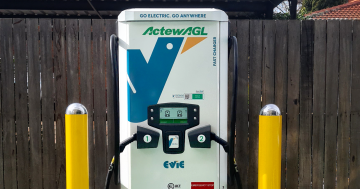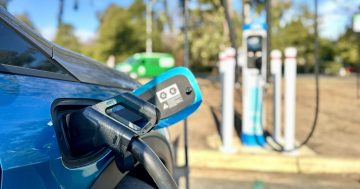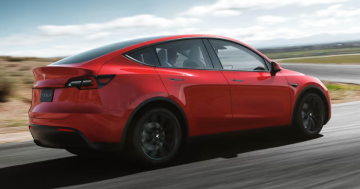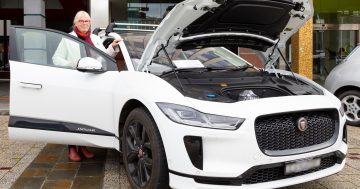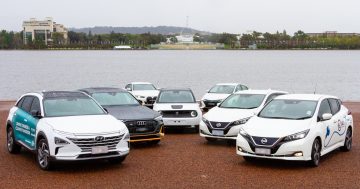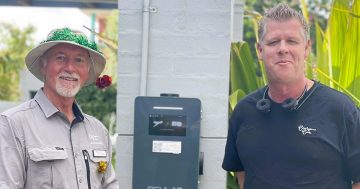
The change is on: ActewAGL CEO John Knox, Evie Networks CEO Chris Mills, Evie Networks CEO, and Australian Electric Vehicle Association, ACT Branch chair Rob Ogilvie at the launch of the charging stations deal this week. Photo: Ian Bushnell.
I’d noticed what looked like a charger on the wall of my neighbour’s carport but hadn’t spotted the car properly until one morning recently when it reversed out, clearly showing the T on the hood.
Yep, my neighbour has a Tesla, in plain old, but upwardly mobile these days, Rivett.
Last weekend at the local shops I saw a Nissan Leaf in the car park.
According to the Australian Electric Vehicle Association, there are 1038 of the new-tech cars running around on ACT roads. They are literally part of a quiet revolution in transport that is becoming more visible, albeit slowly.
I drove a Nissan Leaf earlier in the year, and I’d gladly swap my ageing internal combustion engine runabout for an electric version tomorrow.
Just give me a bit more range and get the price down.
The change is happening, but more slowly than in other parts of the world. Nevertheless, the demand is there, charging networks are being established, and governments at state level are paving the way with incentives and assistance.
This week local energy provider ActewAGL and Evie Networks announced a deal to expand the number of charging stations in the ACT, based on the demand here. This is independent of ACT Government moves for 50 new charge points.
If only the Federal Government would get on board and create the policy settings that would boost supply so the market could become more competitive and create a viable second-hand market.
The sticking point for car manufacturers is that without CO2 reduction targets or fuel-efficiency standards, something other countries have had for years, it’s more economical to focus on markets where they can benefit from carbon offsets.
That means the supply of electric vehicles is limited and prices stay high, despite the hunger for change. It also means Australia risks becoming a dumping ground for ‘dirty’ ICE vehicles while the rest of the world drives into the new era.
In its Future Fuels discussion paper, the Federal Government is focused on co-funding charging infrastructure with the private sector, which is great, but it hasn’t embraced efficiency standards or EV uptake targets, the other side of the equation.
It also hasn’t established any incentives or exempted EVs from the luxury car tax, although it has raised the threshold.
As a result, many potential buyers are holding off until there is more choice or opting for hybrids, sales of which have taken off.
Nonetheless, people with the means and the commitment are still buying EVs. We’re just not seeing as many or the variety of makes as there should be.
At this point, it’s worth remembering why we need to switch to zero-emission vehicles, and it’s not just for cleaner air.
The world needs to curb its greenhouse gas emissions urgently to avoid the catastrophic impacts of global warming, and transport is a big source of emissions.
The Federal Government insists it accepts the science and is committed to reducing emissions, but it seems the politics of climate change and vested interests are keeping it from taking the kind of action that would be meaningful – where the rubber hits the road.
Without that policy certainty, Australian motorists will miss out on the new generation of vehicles that the manufacturers are committed to as they wind down the production of ICE cars, and transport emissions will not come down as they must.
The Federal Government often talks about choice and how it’s not about to force people to give up their petrol or diesel cars.
Well, how about increasing the choice for those of us who want to drive a superior, cleaner and less costly car to run, and taking the imperatives of climate change seriously?












